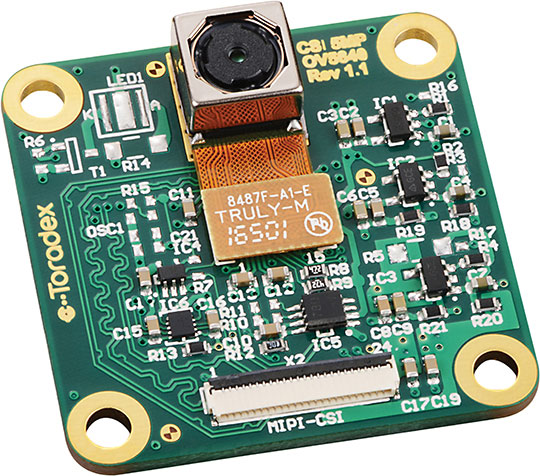CSI Camera Module 5MP OV5640
This product reached its End-of-Life (EOL) and is not available anymore.
Getting Started
Get started with your computer vision-enabled project with this simple to integrated camera module which works directly with our Ixora Carrier Board.
The CSI Camera Module 5MP OV5640 is an add-on board for the Apalis computer-on-module which uses MIPI-CSI Interface. It enables the prototype of machine vision applications and to take advantage of the advanced capabilities of Toradex modules to run deep neural networks, GPU accelerated OpenCV and other high-performance graphics applications. It uses the OmniVision OV5640 camera sensor with built-in auto-focus. The OV5640 image sensor is a low voltage, high-performance, 1/4-inch 5 megapixel CMOS image sensor that provides the full functionality of a single chip 5 megapixel (2592x1944) camera. The CSI Camera Module 5MP OV5640 can be connected to the MIPI-CSI connector on the Ixora carrier board V1.1 using a 24 way 0.5mm pitch FFC cable.
Recommendation for a first-time order
The CSI Camera Module can be ordered with any Apalis module and is compatible with the Ixora Carrier Board V1.1A or newer (and Apalis Evaluation Board via FFC receptacle available on future versions of Apalis mezzanine boards).
All the products can be ordered online at Toradex Webshop
Only the CSI Camera Module 5MP OV5640 V1.1B and newer are compatible with Apalis iMX8.
First Steps
Please read the following articles before using this product.
Having trouble?
Please contact our technical support. Various option of technical support are mentioned in the article below.
Features
Main Features
- MIPI-CSI, Auto-focus OV5640 camera sensor module
- Connects directly to the MIPI-CSI FFC connector on the Apalis carrier boards
- No external power supply required
Datasheets
Design Resources
Design Data for CSI Camera Module 5MP OV5640
- CSI Camera Module 5MP OV5640 Altium Project (Altium Designer Release 10)
- CSI Camera Module 5MP OV5640 PDF Schematics
- CSI Camera Module 5MP OV5640 Assembly Drawing
- CSI Camera Module 5MP OV5640 Bill of Materials (BOM)
Mechanical Models
A basic 3D model for the CSI Camera Module 5MP OV5640 can be downloaded here.
It is a generic STEP model that can be opened and modified in any 3D CAD.It is a generic 3D pdf model that can be opened in Adobe Reader.Compatible Products
Only the CSI Camera Module 5MP OV5640 V1.1B and newer are compatible with Apalis iMX8.
- Verdin iMX8M Mini
- Apalis TK1
- Apalis iMX8
- Apalis iMX8X [2]
- Apalis iMX6
- Apalis T30
- Colibri iMX8X
- Verdin Development Board [1]
- Dahlia Carrier Board [1]
- Ixora Carrier Board [1]
[1] Ixora Carrier Board V1.1 and higher
[2] Apalis iMX8X is phased out, and it is not available for purchase anymore. The latest supported BSP and TorizonCore version is 5.4.0.
The respective Apalis Mezzanine Boards will support the CSI Camera Module 5MP OV5640 as well in their next revision to make it compatible with the Apalis Evaluation Board.
Revision History
| Product # | Product Description | Changes from Previous Version | Release Date | PCN Document |
| 01491100 | CSI Camera Module 5MP OV5640 V1.1A | Initial Release | 2017-09-18 | PCN CSI Camera Module 5MP OV5640 V1.1A |
| 01491101 | CSI Camera Module 5MP OV5640 V1.1B | − Oscillator OSC1 is now assembled and IC4 removed. | 2018-11-22 | EOL Notification CSI Camera Module 5MP OV5640 V1.1B 2020-03-11 |
| 01491125 | CSI Camera Module 5MP OV5640 V1.1Z | − Oscillator OSC1 is now assembled and IC4 removed. − Special version compatible to V1.1B. Released before V1.1B to provide a solution compatible with Apalis iMX8QM and Apalis iMX8QP early access products. | 2018-04-20 | Product is EOL |
Errata
None
